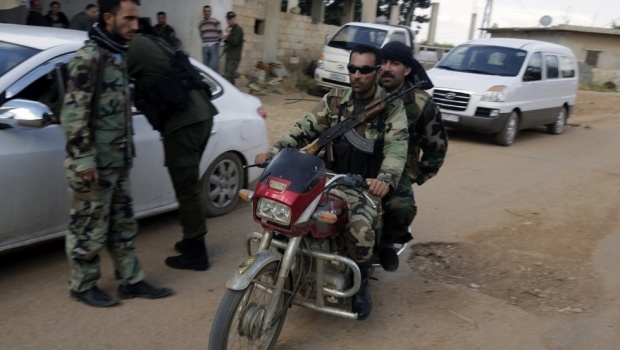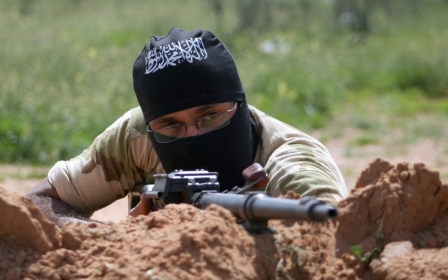Are cracks emerging among pro-Assad forces?

BEIRUT: Bolstered by a coalition of fighters from Lebanon's Hezbollah, as well as Iraqi and other sectarian paramilitary forces, the Syrian regime has made sweeping gains in the civil war in recent months.
Also helping turn the tide, Syrian opposition forces have fragmented and split, with new front lines emerging between Islamist factions once united in their battle against President Bashar al-Assad.
But there are also signs of rifts appearing in the Assad camp, raising concerns that factionalism and a dissolution of any centralized power would await whoever governs Syria after the bloodletting subsides.
Regime-aligned factions have remained far more cohesive, sharing intelligence and coordinating on offensives, though splintering has begun to occur between pro-Assad militias and the Syrian regime on the ground.
The lack of a central command, which has been exploited effectively by the regime to sow sectarian divisions, has emboldened these militias to act in a way that is undermining the regime's diplomatic strategy.
New MEE newsletter: Jerusalem Dispatch
Sign up to get the latest insights and analysis on Israel-Palestine, alongside Turkey Unpacked and other MEE newsletters
Incidents remain limited, but tensions and at times even clashes have been erupted between pro-Assad Syrian militias and the army, as well as between pro-regime Iraqi militias and Lebanese Hezbollah fighters.
"Assad has been able to keep disintegration in check more successfully than I would have expected," said Aron Lund, editor of the Carnegie Endowment for International Peace's “Syria in Crisis” page.
But, he said, "if Assad's influence weakens in a certain area, you're probably going to see some regime-affiliated militias and groups go their own way to protect their interests."
This month, latent hostilities between Hezbollah and the Syrian army were laid bare during a coordinated offensive to retake the Christian enclave of Maaloula, in the Qalamoun region, stretching along the Lebanese border. Hezbollah officials consistently criticised their allies' conduct in battle, complaining of lack of discipline and training, though the tensions were kept under wraps.
Hezbollah has taken the leading role in a highly effective, months-long offensive to consolidate control over Qalamoun. The efforts come after two years of largely unsuccessful efforts to dislodge rebels along the vital artery connecting the capital Damascus, to the central city of Homs, and the northern port provinces of Latakia and Tartous, which are the central stronghold of Assad's Alawite sect.
When three journalists from Hezbollah's Al-Manar television channel were killed in Maaloula, online opposition gossip quickly pointed to the Syrian army. Rumours have circulated that Hezbollah media’s presence on the battlefield had riled Syrian army commanders, who thought the group's exploits were overshadowing their own. Fuelling speculation, Syria recently stopped broadcasting its allies' television channels inside the country.
Syrian army forces were also previously blamed for a civilian deaths during the fighting in Qusayr. The incident caused a disastrous unravelling of a carefully constructed ceasefire plan considered a test case for future negotiations. Some 1,200 people were killed or wounded in an ambush after being promised safe evacuation from the besieged rebel-held neighbourhood.
"The Syrian army spotted gunmen and fired on them. There were civilians among them," a Hezbollah commander told Middle East Eye in Beirut, shortly after returning from his third deployment in Qalamoun last week.
"Hezbollah paid dearly and lost more people than we should have for the sake of civilians. I can assure you, it reached the Secretary General (Hezbollah leader Hassan Nasrallah) that those people would reach safety, even if there were armed men among them," he said of Qusayr.
"We don't trust anybody in Syria, neither the rebels nor the Syrian army."
Orders from God
Hezbollah has justified its intervention in Syria on the basis that it is defending the Shiite community in Lebanon and Shiite shrines in Syria against radical Sunni Islamist rebels. The group’s sponsor, the Shiite Islamic Republic of Iran, is a strong ally of the secular Assad regime, which has helped funnel weapons to Lebanon to fight Israel.
"I don't care about the Bashar Assad regime directly, I am doing my religious duty," the commander said of his reason for fighting.
"But they [the Syrian army] are also our allies. The Syrians allowed all the weapons to come to us for great military success [against Israel]. It is our duty to return the favour."
Religious duty has also been used successfully to recruit thousands of Shiite fighters from Iraq and elsewhere to fight alongside the Syrian regime. Upwards of 10,000 Iraqi fighters, recruited at mosques in Iraq, then trained, armed and paid by Iran, are estimated to be fighting in Syria.
The Shiite fighters have reportedly refused to fight under the command of less qualified pro-Assad Syria Alawite militias or the Syrian army. In one instance the disagreement resulted in at least one deadly gun-battle which broke out near the Shiite shrine of Sayyida Zaynab in Damascus in mid-2013 between an Iraqi factions, government forces and pro-Assad militias.
Infighting and divisions
Phillip Smyth, a researcher at Maryland University and an expert in Shiite militant groups who has been tracking their movements, says while tensions between the different groups have arisen, it has not impacted on overall military coordination.
"They are doing joint operations and cooperating very effectively," he said, adding that friendly fire incidents and small-scale clashes between allies are normal in war.
"There is a religious ruling to go and fight."
"So a fire-fight breaks out occasionally, but when things really hit the fan, they still fight together. I think a lot of this chatter is overstated to fit a rebel narrative."
But as the battlefield becomes more chaotic and as different militias gain control over territory, racketeering and warlordism have taken hold, says explains Lund, adding that there new fronts could soon emerge.
In the absence of a political settlement or outright victory for either side, neighbourhood leaders, tribal figures and militia bosses will develop power bases of their own, he said.
“There’s already talk of how some pro-Assad gangs have begun to self-finance through smuggling, looting, protection rackets and so on. That makes them able to keep fighting for Assad – but it also makes them less dependent on him." he wrote in the blog Syria Comment in July.
"Just like Assad felt the need to reward…other effective Baathist hardliners, he will have to share resources and power with militia commanders on the fringes of the state," Lund said, pointing to Lebanon and Iraq, where protracted civil war saw alliances shift according to local and international dynamics.
Gaining leverage
There are signs paramilitary groups are using this added leverage to drive their own agendas.
In Homs, a final settlement deal to evacuate hundreds of fighters holed up in the government-besieged old city collapsed this month, partly under pressure from pro-Assad militias with the National Defense Forces (NDF), according to fighters involved in negotiations and humanitarian officials.
Localised pro-Assad militias have played an important and increasingly formalised role in bolstering the Syrian army. They have been issued with weapons and uniforms and deployed to sensitive posts where their networks can best be utilized, while localised militias, dubbed "popular committees" have been established under the prefect of defending minority neighbourhoods, including Alawite, Christian, Druze and Armenian.
The NDF were accused of firing at a UN convoy dispatching aid to Old Homs under an initial deal brokered during UN-sponsored peace talks in January. While some speculated the regime ordered the attack, it revealed the power wielded by the militia.
The current deal allegedly fell through in part due to pressure from NDF forces which sought revenge for rebel attacks on Alawite neighbourhoods and demanded the regime take the area militarily. Homs is now under renewed government shelling and negotiations have stalled.
Elsewhere, in the northern city of Aleppo, NDF forces were reportedly arrested after refusing to redeploy to a new front in Latakia. While these reports could not be independently verified, usually reliable opposition sources confirmed the report, saying over a dozen NDF officers had mutinied, but were released shortly after their arrest.
"The commander asked them to go to Latakia and they refused, saying their contract was in Aleppo,” said the Islamic Front source, Abu Kinan.
“There was a fight and three of them were wounded and one was killed," Kinan added while citing intelligence sources inside the Aleppo military academy. MME has been able to see contract agreements for NDF forces stating area of deployment, receipt of one Kalashnikov and a monthly salary of 5,000 Syrian pounds ($34).
Such reports of increasingly autonomy raise questions about whether and how, in the event of any political settlement or victory from either side, the groups could be disbanded or absorbed in a unity state.
Smyth believes Iraqi and other international groups, including Armenians and even Yemeni Shiites, will probably return home after duty in the event of a regime victory. Hezbollah will most likely retain a presence. The Syrian NDF presents a different challenge.
"When the NDF is taking over these internal security roles, there is little the Assad government can do to reign them in. A lot of anger and desire for vengeance has built up, and the training they have undergone makes them a very potent fighting force."
He believes the NDF will be reconstructed along the lines of the Iranian Basij - a feared religiously hard-line Iranian volunteer army set up by Ayatollah Khomeini in 1979 and frequently called on to quell protest.
"If they are still in place they will continue to clamp down locally. They could also be used regionally," he said.
Zones of control
Lund believes the resource-rich Kurdish areas to the north and east of the country, where the regime has relinquished a degree of control in a negotiated co-existence with the local proxy of the Kurdistan Worker's Party (PKK), is one example of how Assad may be weak enough in the future to be forced to negotiate control.
There, the Kurds have already announced an autonomy government and their security role and control of resources could be used as a bargaining chip for greater autonomy by the Kurds in the future.
"But in a situation five or 10 years from now, when getting rid of Assad is no longer the overriding concern … these groups will not have anything to unite them. If there is no imposed solution, or a compromise … you will see fighting according to ideology, or tribal fighting or warlords," he said of the opposition forces.
Something similar could happen to regime factions.
"If Assad can no longer pay and arm them and if he can no longer punish them by cutting payments or bombing their villages – then why exactly would they fight to keep him in power? How is he even relevant to them, at that point?"
- Lauren Williams is an Australian freelance journalist based in Beirut. She is the former Middle East Editor at The Daily Star, Lebanon and the former Managing Editor of Forward Syria. Before moving to the region she was a staff reporter at The Daily Telegraph, Sydney. Her freelance work has appeared in Al Jazeera, The Guardian and The National, amongst others
The views expressed in this article belong to the author and do not necessarily reflect the editorial policy of Middle East Eye.
Photo: Syrian National Defence Forces patrol the village of Ghassaniyeh in the countryside of the rebel city of Qusayr (AFP)
Middle East Eye delivers independent and unrivalled coverage and analysis of the Middle East, North Africa and beyond. To learn more about republishing this content and the associated fees, please fill out this form. More about MEE can be found here.



